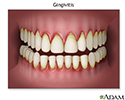Gingivostomatitis
Gingivostomatitis is an infection of the mouth and gums that leads to swelling and sores. It may be due to a virus or bacteria.
Causes
Gingivostomatitis is common among children. It may occur after infection with the herpes simplex virus type 1 (HSV-1), which also causes cold sores.
Cold sores
Herpetic stomatitis is a viral infection of the mouth that causes sores and ulcers. These mouth ulcers are not the same as canker sores, which are n...

The condition may also occur after infection with a coxsackie virus.
Coxsackie virus
Herpangina is a viral illness that involves ulcers and sores (lesions) inside the mouth, a sore throat, and fever. Hand, foot, and mouth disease is a...

It may occur in people with poor oral hygiene.
Symptoms
The symptoms can be mild or severe and may include:
-
Bad breath
Bad breath
Breath odor is the scent of the air you breathe out of your mouth. Unpleasant breath odor is commonly called bad breath.
 ImageRead Article Now Book Mark Article
ImageRead Article Now Book Mark Article - Fever
- General discomfort, uneasiness, or ill feeling (malaise)
- Sores on the inside of the cheeks or gums
- Very sore mouth with no desire to eat
Exams and Tests
Your health care provider will check your mouth for small ulcers. These sores are similar to mouth ulcers caused by other conditions. Cough, fever, or muscle aches may indicate other conditions.
Most of the time, no special tests are needed to diagnose gingivostomatitis. However, the provider may take a swab from the sore to check for a viral or bacterial infection. This is called a culture. A biopsy may be done to rule out other types of mouth ulcers.
Biopsy
A biopsy is the removal of a small piece of tissue for lab examination.

Treatment
The goal of treatment is to reduce symptoms.
Things you can do at home include:
- Practice good oral hygiene. Brush your gums well to reduce the risk of getting another infection.
Oral hygiene
Tooth decay and gum disease are caused by plaque, a sticky combination of bacteria and food. Plaque begins to build up on teeth within a few minutes...
 ImageRead Article Now Book Mark Article
ImageRead Article Now Book Mark Article - Use mouth rinses that reduce pain if your provider recommends them.
- Rinse your mouth with salt water (1/2 tsp [3 g] salt in 1 cup [240 mL] of water) or mouthwashes with hydrogen peroxide or Xylocaine to ease discomfort.
- Eat a healthy diet. Soft, bland (non-spicy) foods may reduce discomfort during eating.
You may need to take antibiotics.
You may need to have the infected tissue removed by the dentist (called debridement).
Outlook (Prognosis)
Gingivostomatitis infections range from mild to severe and painful. The sores often get better in 2 or 3 weeks with or without treatment. Treatment may reduce discomfort and speed healing.
Possible Complications
Gingivostomatitis may disguise other, more serious mouth ulcers.
When to Contact a Medical Professional
Contact your provider if:
- You have mouth sores and fever or other signs of illness
- Mouth sores get worse or do not respond to treatment within 3 weeks
- You develop swelling in the mouth
References
Christian JM, Felts CB, Beckmann NA, Gillespie MB. Deep neck and odontogenic infections. In: Flint PW, Francis HW, Haughey BH, et al, eds. Cummings Otolaryngology: Head and Neck Surgery. 7th ed. Philadelphia, PA: Elsevier; 2021:chap 9.
Romero JR. Coxsackieviruses, echoviruses, and numbered enteroviruses (EV-A71, EV-D68, EVD-70). In: Bennett JE, Dolin R, Blaser MJ, eds. Mandell, Douglas, and Bennett's Principles and Practice of Infectious Diseases. 9th ed. Philadelphia, PA: Elsevier; 2020:chap 172.
Shaw J. Infections of the oral cavity. In: Long SS, ed. Principles and Practice of Pediatric Infectious Diseases. 6th ed. Philadelphia, PA: Elsevier; 2023:chap 25.
Whitley RJ, Gnann JW. Herpes simplex virus infections. In: Goldman L, Cooney KA, eds. Goldman-Cecil Medicine. 27th ed. Philadelphia, PA: Elsevier; 2024:chap 345.
-
Gingivitis - illustration
Inflammation of the gums is called gingivitis. Bacteria in plaque around the teeth release enzymes (collagenases) that can damage and erode the gum tissues. The infected gums swell, bleed easily, recede, and loosen from the teeth. Tooth loss is caused more frequently by gum disease than tooth decay.
Gingivitis
illustration
-
Gingivitis - illustration
Gingivitis is an inflammation of the gums caused by plaque and bacteria accumulation.
Gingivitis
illustration
-
Gingivitis - illustration
Inflammation of the gums is called gingivitis. Bacteria in plaque around the teeth release enzymes (collagenases) that can damage and erode the gum tissues. The infected gums swell, bleed easily, recede, and loosen from the teeth. Tooth loss is caused more frequently by gum disease than tooth decay.
Gingivitis
illustration
-
Gingivitis - illustration
Gingivitis is an inflammation of the gums caused by plaque and bacteria accumulation.
Gingivitis
illustration
Review Date: 1/29/2025
Reviewed By: Ashutosh Kacker, MD, FACS, Professor of Clinical Otolaryngology, Weill Cornell Medical College, and Attending Otolaryngologist, New York-Presbyterian Hospital, New York, NY. Review provided by VeriMed Healthcare Network. Also reviewed by David C. Dugdale, MD, Medical Director, Brenda Conaway, Editorial Director, and the A.D.A.M. Editorial team.



